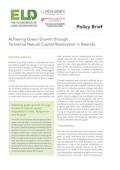This is the fourth edition of the ground-breaking Chilling Prospects series of SEforALL, which tracks immediate vulnerability due to a lack of access to cooling. The work identifies populations at risk for whom a lack of access to cooling threatens their immediate health and safety.
The post-2020 Global Biodiversity Framework (GBF) will be a major milestone in global agreements on biodiversity conservation, setting international ambition for the next decade. This guide is intended to support Parties to the Convention on Biological Diversity (CBD) who wish to see strengthened equity provisions in the draft GBF.
To help facilitate progress, this paper serves as a nontechnical entry point for actors keen to navigate the environment-trade policy conversation and drive forward green trade. It maps the current state of play and highlights a range of possible pathways forward.
Zambia is one of the fastest growing economies in Sub-Saharan Africa. The country is endowed with rich natural resources: minerals, forests, agricultural land and water resources. Sustaining long-term economic development requires the use of existing natural resources in an effective and efficient way that delivers benefits to communities, economies and the environment.

This policy brief summarizes the use of the innovative integrated economic and environmental model (IEEM) coupled with land use land cover (LULC), and ecosystem service models (IEEM+ESM) to understand how various policy interventions can affect economic, poverty amelioration, and environmental outcomes in Rwanda.
